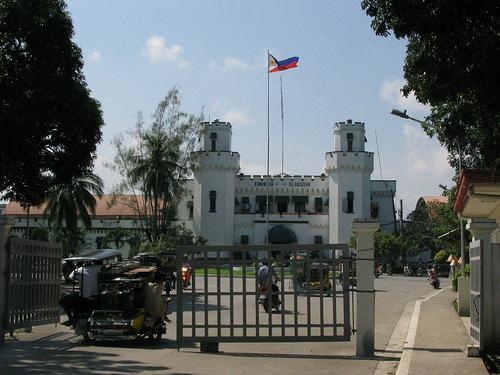
The National Bureau of Prison Reservation or the New Bilibid Prison in Muntinlupa City is the main insular penitentiary designed to house the prison population of the Philippines. It is maintained by the Bureau of Corrections (BuCor) under the Philippine Department of Justice. The penitentiary had an initial land area of 551 hectares. The Bureau of Corrections has its headquarters in the NBP Reservation and 104 hectares of the facility were transferred to a housing project of the Department of Justice.
Overview
The Old Bilibid Prison, then known as Carcel y Presidio Correccional (Correctional Jail and Military Prison) occupied a rectangular piece of land which was part of the Mayhalique Estate in the heart of Manila. The old prison was established on June 25, 1865 under a Spanish royal decree and divided into two sections: the Carcel and the Presidio Section. Due to increasing crime rate, the Philippine Government enacted Commonwealth Act No. 67 and a new prison was built in Muntinlupa with 551 hectares of land at an area considered at that time to be "remote". Construction was begun in 1936. In 1940, the prisoners’ equipment and facilities were transferred to the new prison. The remnants of the old facility was used by the City of Manila as its detention center then known as Manila City Jail. In 1941 the new facility was officially named "The New Bilibid Prison".
Recreational Facilities
• During pasttime, the prisoners can play in the basketball court in the penitentiary's gymnasium.
• They are also engaged in the production of handicrafts.
• Various religious organizations are active in the prison and daily masses are held in the prison's chapel.
• The New Bilibid Prison also houses a talipapa (market) where the prisoners can buy commodities.
• Educational facilities inside the compound provide elementary education, high school education, vocational training, and adult literacy programs.
• It also provides a Bachelor's Degree in Commerce. Medical services are given by religious groups and charitable organizations such as the Seventh-day Adventist Church, Amazing Grace Christian ministries, Philippine Prison Jesuit Service, and Caritas Manila.
The NBP Compound is not just an area for criminals; it is also a home to a park, several historical sites, schools, and a housing project.
• NBP is the home to Jamboree Lake known as the smallest natural lake in the country. It is a favorite hangout spot for nature lovers, as well as ordinary passers-by looking for a cool respite from the tropical heat. The lake has been in existence since time immemorial.
• The small hill in the NBP reservation compound that cradles a World War II Vintage Japanese canon. The hill is likewise the burial place of Eriberto Misa the famous Prison`s Director from 1937 to 1949.
• The Director's Quarters structure manifest an influence of a pre-war architecture that chracterizes the outstanding edifice. This was built simultaneously with the Administration Building in 1941. This is also the official residence of the Director of Bureau of Corrections.
• The cemetery inside the NBP compound is a burial place of General Yamashita, the Japanese General who became famous during the Japanese occupation of the country.









